Digital Transformation and its Impact on Organizations’
Added on 2022-06-08
30 Pages8817 Words28 Views
Pranjali Galgali, IOR and Stakeholder Management, MCM, School of Communication and Information, Rutgers University
1
Digital Transformation and its Impact on
Organizations’ Human Resource Management
WHITE PAPER
December 18, 2017
Abstract:
Digital transformation has revolutionized employee engagement and organizational
communication. This paper studies the influence of digitization on organization’s human
resource management (HRM) function in the context of Stakeholder Theory. It highlights the role
of business leaders, HR teams and employees in shaping interorganizational communication
juxtaposed the technological, social and behavioral changes. While focusing on internal
communication tools such as e-mails, intranet, newsletters, etc., the paper reviews
opportunities, challenges, risks and industry best practices in the engagement of stakeholders.
CONTENTS
INTRODUCTION 2
KEY TERMS 4
LIVING THE DIGITAL CHANGE 7
STAKEHOLDER MANAGEMENT VS STAKEHOLDER
ENGAGEMENT 11
TECHNOLOGICAL ENGAGEMENT AND
CHALLENGES 15
APPENDIX 14
REFERENCES 18
1
Digital Transformation and its Impact on
Organizations’ Human Resource Management
WHITE PAPER
December 18, 2017
Abstract:
Digital transformation has revolutionized employee engagement and organizational
communication. This paper studies the influence of digitization on organization’s human
resource management (HRM) function in the context of Stakeholder Theory. It highlights the role
of business leaders, HR teams and employees in shaping interorganizational communication
juxtaposed the technological, social and behavioral changes. While focusing on internal
communication tools such as e-mails, intranet, newsletters, etc., the paper reviews
opportunities, challenges, risks and industry best practices in the engagement of stakeholders.
CONTENTS
INTRODUCTION 2
KEY TERMS 4
LIVING THE DIGITAL CHANGE 7
STAKEHOLDER MANAGEMENT VS STAKEHOLDER
ENGAGEMENT 11
TECHNOLOGICAL ENGAGEMENT AND
CHALLENGES 15
APPENDIX 14
REFERENCES 18
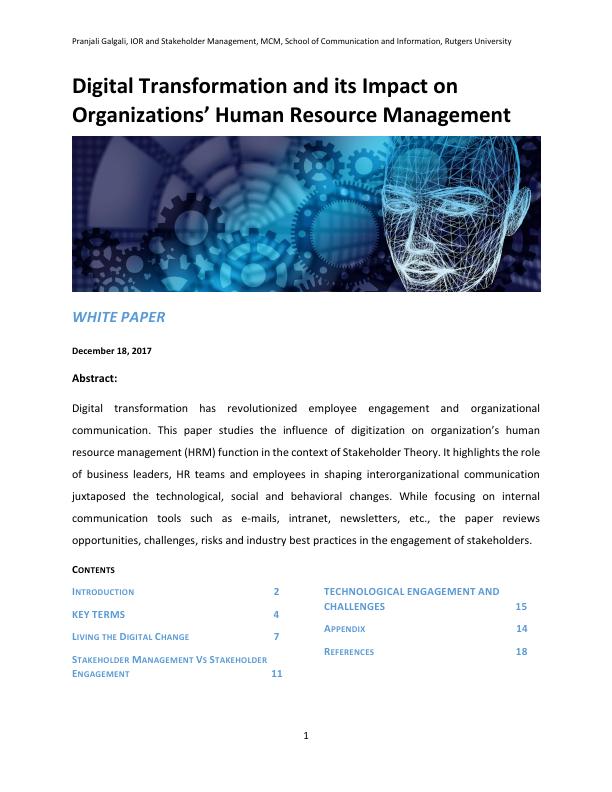
Pranjali Galgali, IOR and Stakeholder Management, MCM, School of Communication and Information, Rutgers University
2
INTRODUCTION:
In the recent years, digitalization has deepened the reliance on data analytics, social networks and
mobile technologies, and has dramatically reformed the role of communications in businesses. In
order to utilize technological advances towards the engagement of stakeholders, as well as
adapting to the digital transformation, several organizations have taken essential steps to develop
a strategic framework for organizational priorities. Business leaders have played a vital role in
changing paradigms by fostering newer perspectives of people communication, reducing
functional hierarchies and endorsing internal and external stakeholder engagement. It is evident
that while digitalization has brought numerous challenges, it has also given organizations an
opportunity to reshape their public image, construct meaningful value-based dialogue on public
platforms, and reinforce their objectives through a well-designed human resources management
function.
The Digital Transformation Initiative (DTI) launched by the World Economic Forum in 2015 is
one such attempt to function as a platform for organizations to understand the change and embrace
newer opportunities and themes, arising from the latest developments in the digitalization of
business and society. The initiative states potential risks encountered by diverse industries and
sectors along with a model of change (Digital Transformation, 2016). The report states, “By 2025,
it is predicted that Millennials will be 75% of the workforce, requiring us to engage, develop, and
retain this new generation of talent in new ways”. Studies also show that ‘transformation,
leadership, and strategy are the core skills of the future’ (McInnis-Day, 2014).
Digital disruption has wrecked almost all industries and has made the traditional communication
models redundant. To survive in the ‘digital-first world’, organizations have introduced an agile
and flexible strategy to communicate with their internal and external stakeholders. Digital
2
INTRODUCTION:
In the recent years, digitalization has deepened the reliance on data analytics, social networks and
mobile technologies, and has dramatically reformed the role of communications in businesses. In
order to utilize technological advances towards the engagement of stakeholders, as well as
adapting to the digital transformation, several organizations have taken essential steps to develop
a strategic framework for organizational priorities. Business leaders have played a vital role in
changing paradigms by fostering newer perspectives of people communication, reducing
functional hierarchies and endorsing internal and external stakeholder engagement. It is evident
that while digitalization has brought numerous challenges, it has also given organizations an
opportunity to reshape their public image, construct meaningful value-based dialogue on public
platforms, and reinforce their objectives through a well-designed human resources management
function.
The Digital Transformation Initiative (DTI) launched by the World Economic Forum in 2015 is
one such attempt to function as a platform for organizations to understand the change and embrace
newer opportunities and themes, arising from the latest developments in the digitalization of
business and society. The initiative states potential risks encountered by diverse industries and
sectors along with a model of change (Digital Transformation, 2016). The report states, “By 2025,
it is predicted that Millennials will be 75% of the workforce, requiring us to engage, develop, and
retain this new generation of talent in new ways”. Studies also show that ‘transformation,
leadership, and strategy are the core skills of the future’ (McInnis-Day, 2014).
Digital disruption has wrecked almost all industries and has made the traditional communication
models redundant. To survive in the ‘digital-first world’, organizations have introduced an agile
and flexible strategy to communicate with their internal and external stakeholders. Digital
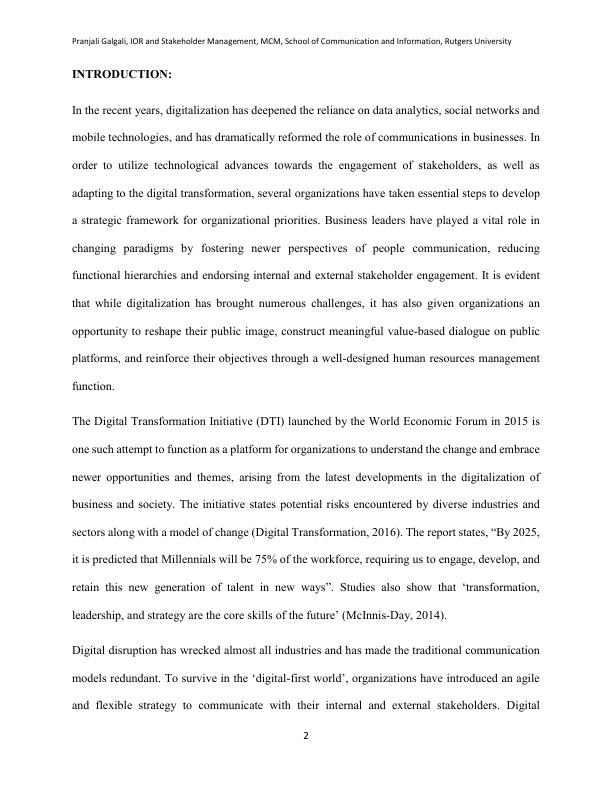
Pranjali Galgali, IOR and Stakeholder Management, MCM, School of Communication and Information, Rutgers University
3
technology such as file-sharing, social-sites, online-advertising and electronic books have created
challenges in maintaining workflows, managing processes, planning resources and streamlining
communications amongst the stakeholders (OpenText, 2015). In the context of stakeholder theory,
this paper argues that interorganizational stakeholder relationship affects the nature of external
communication and is publicly negotiated. The author says that the nature of Human Resource
Management is redefined when internal sentiments are publicly shared. The paper also focuses on
internal and external portals such as Glassdoor, LinkedIn, internal HRM sites, etc. that reshape the
stakeholder relationships.
This paper aims to help business leaders, HR professionals and academicians in understanding the
role of leadership in digital transformation and assess its impact on the Human Resources (HR)
function of any organization. While considering the industry best practices of recruitment, training,
performance management, learning and development, compensation and employee engagement,
the paper provides insights and tools for business communications model changes within the
organization. By unlocking new levels of engagement and introducing technological tools for
stakeholder engagement, the author defines roles of business leaders, functional heads and
employees in adopting this digital change. With the focus on communication as the epicenter of
digitalization, the paper aims to present its correlation with interorganizational and stakeholder
theories with practical applications and suggestive changes.
3
technology such as file-sharing, social-sites, online-advertising and electronic books have created
challenges in maintaining workflows, managing processes, planning resources and streamlining
communications amongst the stakeholders (OpenText, 2015). In the context of stakeholder theory,
this paper argues that interorganizational stakeholder relationship affects the nature of external
communication and is publicly negotiated. The author says that the nature of Human Resource
Management is redefined when internal sentiments are publicly shared. The paper also focuses on
internal and external portals such as Glassdoor, LinkedIn, internal HRM sites, etc. that reshape the
stakeholder relationships.
This paper aims to help business leaders, HR professionals and academicians in understanding the
role of leadership in digital transformation and assess its impact on the Human Resources (HR)
function of any organization. While considering the industry best practices of recruitment, training,
performance management, learning and development, compensation and employee engagement,
the paper provides insights and tools for business communications model changes within the
organization. By unlocking new levels of engagement and introducing technological tools for
stakeholder engagement, the author defines roles of business leaders, functional heads and
employees in adopting this digital change. With the focus on communication as the epicenter of
digitalization, the paper aims to present its correlation with interorganizational and stakeholder
theories with practical applications and suggestive changes.
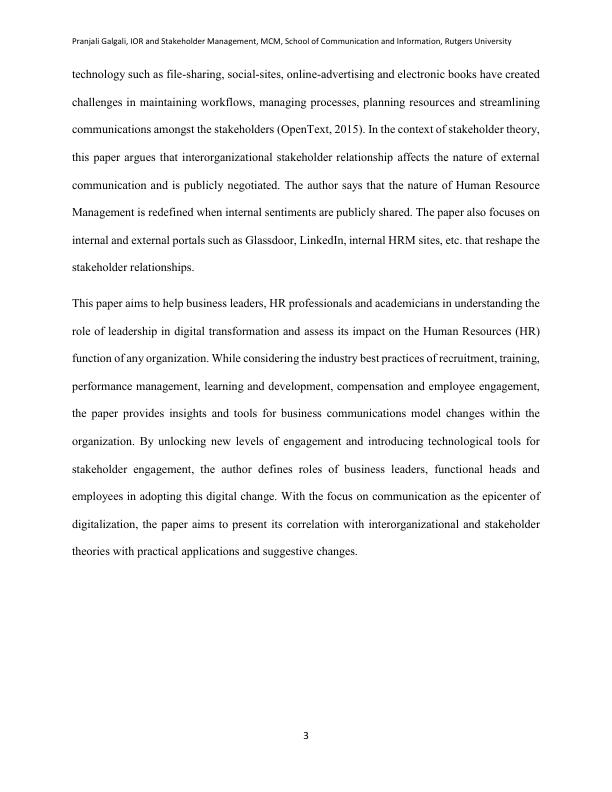
Pranjali Galgali, IOR and Stakeholder Management, MCM, School of Communication and Information, Rutgers University
4
KEY TERMS:
Stakeholders, Stakeholder Management and Engagement
According to Freeman’s definition, stakeholder is 'any group or individual who can affect or is
affected by the achievement of the organization's objectives' (Freeman R. E., 1984). In the recent
times, (Carroll & Buchholtz, 2009) say that stakeholder is “an individual or a group that claims to
have one or more stakes in an organization. Stakeholders may affect the organization and, in turn,
be affected by the organization's actions, policies, practices and decisions.” According to the
stakeholder theory of organization, employees are internal stakeholders of the company (Freeman
R. E., 1984). He also says that employees can be one of the most important stakeholders for any
organization. The stakeholder approach to internal communication emphasizes on the needs and
preferences of employees, as against the previous focus on managerial inclinations (Welch M. ,
2012). Freeman, at first, struggled using ‘internal stakeholder’, as he anticipated businesses
focusing on external stakeholders such as suppliers, society, government, shareholders, customers
and creditors. However, later, he recognized employees as a diverse group of people who have
stakes in the organization (Evan & Freeman, 1988).
Thus, understanding internal stakeholders is imperative in engaging them in a dyadic relationship.
Welch and Johnson argue that internal stakeholder groups have to be identified according to
geographical, occupational and structural levels in order to classify them into separate groups,
instead of calling this diverse group as one cluster (Welch & Jackson, 2007). Therefore, the HR
teams have to form multiple small and big clusters to ensure targeted communications across all
divisions and hierarchies. (Friedman, 1970) believes that organization itself should think of
forming groups of stakeholders according to their interests, needs and viewpoints and this should
be imbibed in the purpose of the organization.
4
KEY TERMS:
Stakeholders, Stakeholder Management and Engagement
According to Freeman’s definition, stakeholder is 'any group or individual who can affect or is
affected by the achievement of the organization's objectives' (Freeman R. E., 1984). In the recent
times, (Carroll & Buchholtz, 2009) say that stakeholder is “an individual or a group that claims to
have one or more stakes in an organization. Stakeholders may affect the organization and, in turn,
be affected by the organization's actions, policies, practices and decisions.” According to the
stakeholder theory of organization, employees are internal stakeholders of the company (Freeman
R. E., 1984). He also says that employees can be one of the most important stakeholders for any
organization. The stakeholder approach to internal communication emphasizes on the needs and
preferences of employees, as against the previous focus on managerial inclinations (Welch M. ,
2012). Freeman, at first, struggled using ‘internal stakeholder’, as he anticipated businesses
focusing on external stakeholders such as suppliers, society, government, shareholders, customers
and creditors. However, later, he recognized employees as a diverse group of people who have
stakes in the organization (Evan & Freeman, 1988).
Thus, understanding internal stakeholders is imperative in engaging them in a dyadic relationship.
Welch and Johnson argue that internal stakeholder groups have to be identified according to
geographical, occupational and structural levels in order to classify them into separate groups,
instead of calling this diverse group as one cluster (Welch & Jackson, 2007). Therefore, the HR
teams have to form multiple small and big clusters to ensure targeted communications across all
divisions and hierarchies. (Friedman, 1970) believes that organization itself should think of
forming groups of stakeholders according to their interests, needs and viewpoints and this should
be imbibed in the purpose of the organization.
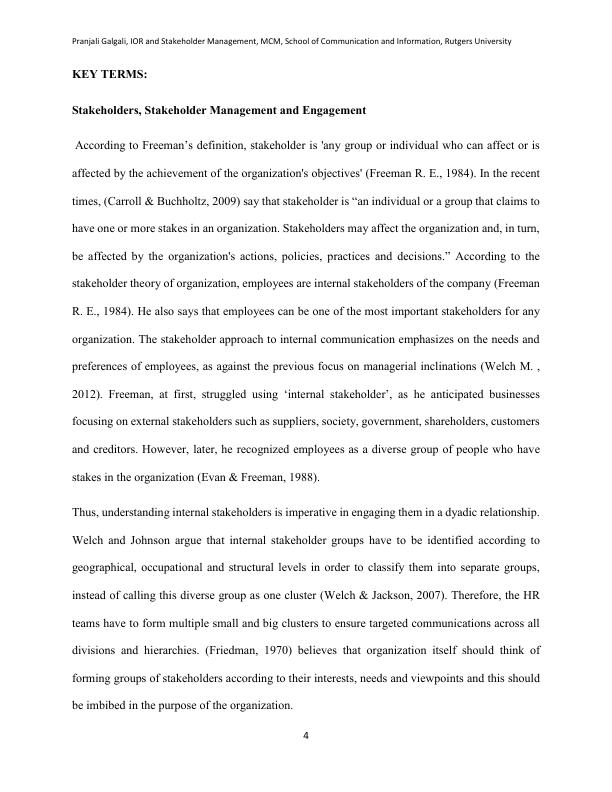
Pranjali Galgali, IOR and Stakeholder Management, MCM, School of Communication and Information, Rutgers University
5
In the book Strategic Management, A Stakeholder Approach, Freeman (1984) says that traditional
approaches of management and strategic decision-making are not helping managers anymore to
develop new paradigms of change. Therefore, he defined ‘Stakeholder Theory’ as a conceptual
approach to tap opportunities and increase productivity. He believes that the primary objective of
the stakeholder approach is “to manage and integrate the relationships and interests of
shareholders, employees, customers, suppliers, communities and other groups in a way that
guarantees the long-term success of the firm”. There are different definitions and approaches
discussed in the theory.
Organizational and Internal Communication Design
Organizational communication comprises of various forms of communication ‘that flow among
and between organizational units and groups’ (Cornelissen, 2002). It can happen at various levels,
and can involve small or big team members, interpersonal and dyadic interactions, small groups
or teams, written or oral communication within or across organizational departments or units,
organizations regardless of geographical boundaries. While the primary focus of
interorganizational communication is value creation, studies have found that humans relations are
based on social interaction and attention (Ansoff, 1965). (Deetz, 2001) has classified internal
communications in two ways. The first and most common approach focuses organization within
which internal communication happens: a “phenomenon that exists in organizations”. The second
approach emphasizes on communication at the center of information-sharing, relationship-
building, and making meaning or constructing organizational culture and values: “a way to
describe and explain organizations”. Research shows that this is a combination of people,
messages, meaning, practices and purpose (Shockley-Zalabak, 2008), and it is the basis of
contemporary organizations (Gillis, 2006).
5
In the book Strategic Management, A Stakeholder Approach, Freeman (1984) says that traditional
approaches of management and strategic decision-making are not helping managers anymore to
develop new paradigms of change. Therefore, he defined ‘Stakeholder Theory’ as a conceptual
approach to tap opportunities and increase productivity. He believes that the primary objective of
the stakeholder approach is “to manage and integrate the relationships and interests of
shareholders, employees, customers, suppliers, communities and other groups in a way that
guarantees the long-term success of the firm”. There are different definitions and approaches
discussed in the theory.
Organizational and Internal Communication Design
Organizational communication comprises of various forms of communication ‘that flow among
and between organizational units and groups’ (Cornelissen, 2002). It can happen at various levels,
and can involve small or big team members, interpersonal and dyadic interactions, small groups
or teams, written or oral communication within or across organizational departments or units,
organizations regardless of geographical boundaries. While the primary focus of
interorganizational communication is value creation, studies have found that humans relations are
based on social interaction and attention (Ansoff, 1965). (Deetz, 2001) has classified internal
communications in two ways. The first and most common approach focuses organization within
which internal communication happens: a “phenomenon that exists in organizations”. The second
approach emphasizes on communication at the center of information-sharing, relationship-
building, and making meaning or constructing organizational culture and values: “a way to
describe and explain organizations”. Research shows that this is a combination of people,
messages, meaning, practices and purpose (Shockley-Zalabak, 2008), and it is the basis of
contemporary organizations (Gillis, 2006).
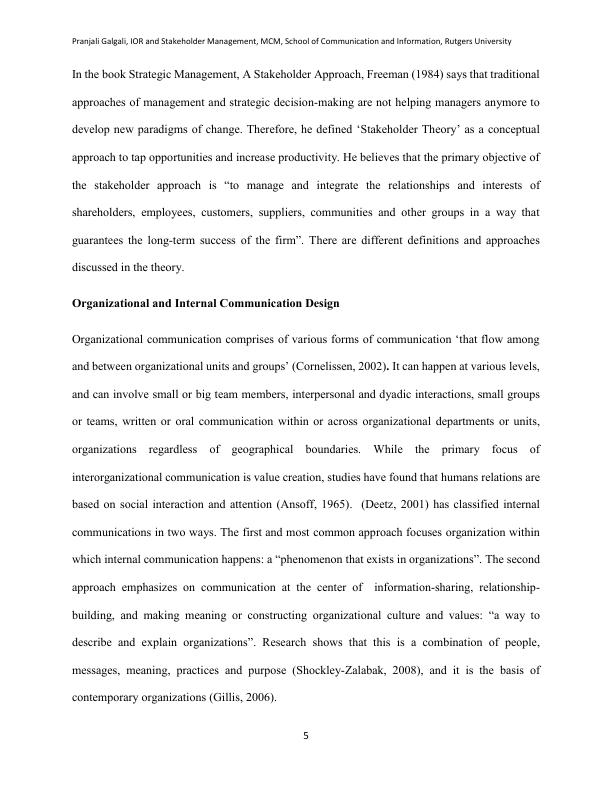
Pranjali Galgali, IOR and Stakeholder Management, MCM, School of Communication and Information, Rutgers University
6
There are several networks and roles in organizational communication ‘such as gatekeepers (who
filter communication to a specific manager or upward through the organization), liaisons (who
mediate interaction between two groups), bridges (a group member who mediates interaction with
outside individuals), cosmopolite or boundary spanner (one who monitors the environment and
brings new information into the organization), cliques (members who communicate more with
each other than with other members), and grapevines and rumor networks (where members
communicate through informal and social networks about salient, time-sensitive topics)
(Trenholm, 2005) (Neher, 1997) (Miller, 1997).
Communication within these networks and roles can be managed by the HR teams in order to
facilitate vertical and horizontal communication. While vertical communication usually takes
place between managers and their subordinates, horizontal communication is the exchange of
messages between the same hierarchy. According to (Cornelissen, 2002), there are two parts of
vertical communication: “Upward communication consists of messages from subordinates to
superiors, whilst downward communication occurs when information flows down the hierarchy
from superiors to subordinates”.
According to the Institute of Public Relations, internal communications is an important
communication tool to build trust, motivate employees, create a shared identity and build
engagement besides providing important information about the work, organization, environment
and each other. It is one of the important platforms that help employees express their voice, share
opinions, celebrate and remember accomplishments. Lastly, the study of Interorganizational
communication is an overarching term used to study a wide gamut of entities and organizing acts
that comprise of several relationships.
6
There are several networks and roles in organizational communication ‘such as gatekeepers (who
filter communication to a specific manager or upward through the organization), liaisons (who
mediate interaction between two groups), bridges (a group member who mediates interaction with
outside individuals), cosmopolite or boundary spanner (one who monitors the environment and
brings new information into the organization), cliques (members who communicate more with
each other than with other members), and grapevines and rumor networks (where members
communicate through informal and social networks about salient, time-sensitive topics)
(Trenholm, 2005) (Neher, 1997) (Miller, 1997).
Communication within these networks and roles can be managed by the HR teams in order to
facilitate vertical and horizontal communication. While vertical communication usually takes
place between managers and their subordinates, horizontal communication is the exchange of
messages between the same hierarchy. According to (Cornelissen, 2002), there are two parts of
vertical communication: “Upward communication consists of messages from subordinates to
superiors, whilst downward communication occurs when information flows down the hierarchy
from superiors to subordinates”.
According to the Institute of Public Relations, internal communications is an important
communication tool to build trust, motivate employees, create a shared identity and build
engagement besides providing important information about the work, organization, environment
and each other. It is one of the important platforms that help employees express their voice, share
opinions, celebrate and remember accomplishments. Lastly, the study of Interorganizational
communication is an overarching term used to study a wide gamut of entities and organizing acts
that comprise of several relationships.
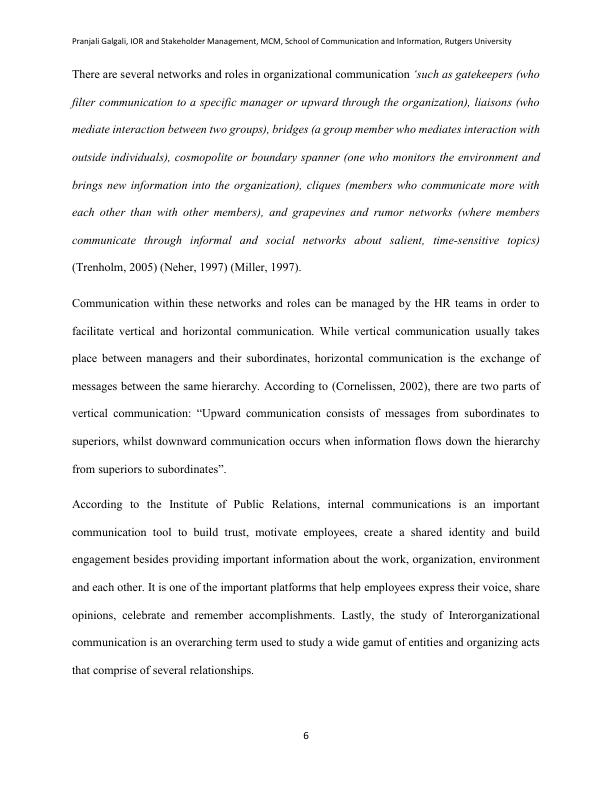
End of preview
Want to access all the pages? Upload your documents or become a member.
Related Documents
Skype: Technological and Commercial Viability Analysislg...
|15
|3312
|367
System Engineering for Managerslg...
|8
|2090
|53
Impact of Digital Technology on Business Operationslg...
|31
|4646
|68
Impact of Social Media on Modern Business Communicationlg...
|10
|2908
|77
Report on Impact of Digital Marketing in Business - eBay Companylg...
|22
|5377
|43
Business Transformation Planninglg...
|22
|4615
|301
